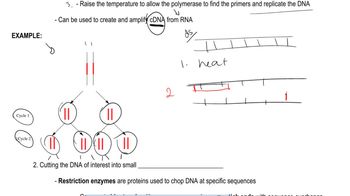Here are the essential concepts you must grasp in order to answer the question correctly.
Restriction Enzymes
Restriction enzymes are proteins that cut DNA at specific sequences, known as restriction sites. They are essential tools in molecular biology for cloning and analyzing DNA fragments. Different enzymes recognize different sequences, which can lead to varying fragment sizes when DNA is digested. Understanding how these enzymes work is crucial for interpreting results from genomic and cDNA clones.
Recommended video:
Genomic vs. cDNA Clones
Genomic clones contain the entire genomic DNA, including introns, exons, and regulatory regions, while cDNA clones are synthesized from mRNA and represent only the expressed genes (exons). This difference means that cDNA clones lack intronic sequences, which can affect the presence of restriction sites. Consequently, restriction sites found in genomic DNA may not always be present in cDNA clones due to splicing.
Recommended video:
Gene Structure and Splicing
Gene structure refers to the arrangement of exons and introns within a gene. During the process of splicing, introns are removed from the pre-mRNA transcript, resulting in a mature mRNA that only contains exons. This process can lead to the absence of certain restriction sites in cDNA clones that are present in the genomic DNA, as the sites may be located within introns that are not included in the final mRNA product.
Recommended video:






